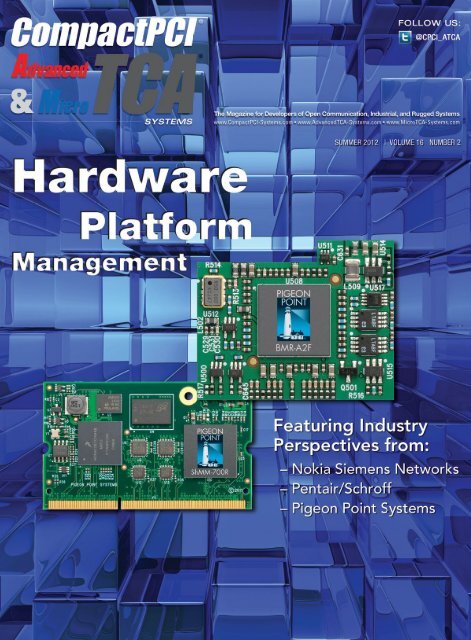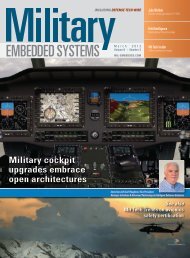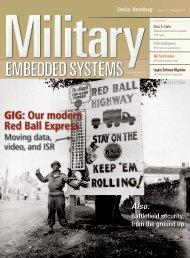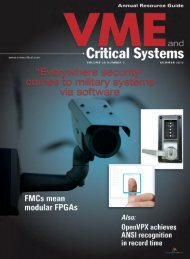Arrive on Time with X-ES. - OpenSystems Media
Arrive on Time with X-ES. - OpenSystems Media
Arrive on Time with X-ES. - OpenSystems Media
- No tags were found...
Create successful ePaper yourself
Turn your PDF publications into a flip-book with our unique Google optimized e-Paper software.
FRUSTRATED BY DELAYS?<str<strong>on</strong>g>Arrive</str<strong>on</strong>g> <strong>on</strong> <strong>Time</strong> <strong>with</strong> X-<strong>ES</strong>.Is your embedded computing vendor causing frustrating delays? At X-<strong>ES</strong>,we know the importance of keeping your project <strong>on</strong> schedule. Decisi<strong>on</strong>s<strong>on</strong> custom requests are made quickly. Proposals are resp<strong>on</strong>ded topromptly. X-<strong>ES</strong> customer support provides direct access to engineeringexpertise and fast, accurate answers. With a proven history of meeting ourcustomers’ aggressive schedules, X-<strong>ES</strong> is the choice to eliminate delays.Keeping your project <strong>on</strong> time. That’s Extreme.Extreme Engineering Soluti<strong>on</strong>s608.833.1155 www.xes-inc.com
SuMMEr 2012 / VOluME 16 NuMbEr 2www.advancedtca-systems.com@cpci_atcaOn the coverCOTS management building blocks forAdvancedTCA: Proven over the first decadeBy Mark Overgaard,Pige<strong>on</strong> Point Systems» p.11Hardware platform management has become a criticalenabler of the c<strong>on</strong>tinuing growth of the ATCA market. COTSmanagement c<strong>on</strong>trollers, such as Pige<strong>on</strong> Point Systems’BMR-A2F board management core (top right) and ShMM-700Rshelf management c<strong>on</strong>troller (bottom left), are an effectiveway to realize the mandatory management c<strong>on</strong>trollers in ATCAboards and shelves, supporting the needs of Tier 1 TEMs forstable, interoperable, cost-effective platforms.» p.15Adaptable AdvancedTCAShelf Manager FirmwareBy Michael Thomps<strong>on</strong>,Pentair Technical Products(Schroff)5 Editor’s Foreword / Brand<strong>on</strong> LewisHPM and managing the “9s”7 Network Intelligence / Curt SchwadererArchitecture, modeling, coordinati<strong>on</strong>, andsynchr<strong>on</strong>izati<strong>on</strong> of multicore applicati<strong>on</strong>s10 4G Focus / Mike DemlerHow <strong>on</strong>e TEM leverages ATCAHardware Platform ManagementBy Jari Ruoh<strong>on</strong>en, Nokia SiemensNetworks» p.19Special Advertising Feature:Interview <strong>with</strong> Thomas Kastner,Chief Architect x86 Software,Advantech Networks &» p.22 Communicati<strong>on</strong>s GroupBase stati<strong>on</strong>s-<strong>on</strong>-a-chip deliver the lowercost per bit promise of 4G LTE networksAdvertiser Index22 Advantech Corporati<strong>on</strong> Interview <strong>with</strong> Thomas Kastner, Chief Architect x86Software24 Annapolis Micro Systems, Inc. High performance signal and data processing20 ATP Electr<strong>on</strong>ics ATP industrial grade flash products and DRAMmodules3 ELMA Electr<strong>on</strong>ic So fast. So cool.9 Excalibur Systems, Inc. Ready for the unexpected?x2 Extreme Engineering Soluti<strong>on</strong>s Frustrated by delays?23 GE Intelligent Platforms, Inc. Enabling and securing the c<strong>on</strong>nected warfighter6 MEN Micro Elektr<strong>on</strong>ik GmbH CompactPCI goes serial13 N.A.T. GmbH The heart of your MTCA system21 Pige<strong>on</strong> Point Systems Celebrating 10 years of delivering xTCAmanagement soluti<strong>on</strong>s17 Sunrich Technology Quality + reliability customizati<strong>on</strong> service16 VEROTEC Electr<strong>on</strong>ics Packaging TecSYS cPCI development platforms12 Wolf Industrial Systems, Inc. Modular video graphic soluti<strong>on</strong>s® 2012 <strong>OpenSystems</strong> <strong>Media</strong>® CompactPCI, PICMG, PICMG, ATCA, AdvancedTCA, MicroTCA, and their logos are registered trademarks of PICMG.TMAdvancedMC and xTCA are trademarks of PICMG.© 2012 CompactPCI AdvancedTCA & MicroTCA SystemsAll registered brands and trademarks in CompactPCI AdvancedTCA & MicroTCA Systems are property of their respective owners. Member since 19984 | Summer 2012 | CompactPCI, AdvancedTCA & MicroTCA Systemsenviroink.indd 110/1/08 10:44:38 AM
CompactPCI ®Goes SerialCompactPCI, Advanced & MicroTCA Systems Editorial/Producti<strong>on</strong> StaffJoe Pavlat, Editorial Directorjpavlat@opensystemsmedia.comMike Demler, Technology Editormdemler@opensystemsmedia.comCurt Schwaderer, Technology Editorcschwaderer@opensystemsmedia.comBrand<strong>on</strong> Lewis, Associate Editorblewis@opensystemsmedia.comDavid Diomede, Art Directorddiomede@opensystemsmedia.comSales Group PCI Express ® , Ethernet, SATA,USB <strong>on</strong> the backplane CompactPCI ® PlusIO(PICMG 2.30) 100%compatible toCompactPCI ® 2.0 CompactPCI ® Serial(PICMG CPCI-S.0) 100%compatible to 19”mechanics (IEEE 1101) Individual system soluti<strong>on</strong>sfrom inexpensive industrialPCs to redundant systemsor complex computer clustersEmbedded Soluti<strong>on</strong>s – RuggedComputer Boards and Systemsfor Harsh, Mobile andMissi<strong>on</strong>-critical Envir<strong>on</strong>mentsMEN Micro, Inc.24 North Main StreetAmbler, PA 19002Tel: 215.542.9575E-mail: sales@menmicro.comwww.men.de/cpci-serialTom Varcie, Senior Account Managertvarcie@opensystemsmedia.comRebecca Barker, Strategic Account Managerrbarker@opensystemsmedia.comEric Henry, Strategic Account Managerehenry@opensystemsmedia.comAnn Jesse, Strategic Account Managerajesse@opensystemsmedia.comChristine L<strong>on</strong>g, Director of Online Developmentcl<strong>on</strong>g@opensystemsmedia.com<strong>OpenSystems</strong> <strong>Media</strong> Editorial/Producti<strong>on</strong> StaffMike Demler, Editorial DirectorDSP-FPGA.commdemler@opensystemsmedia.comJoe Pavlat, Editorial DirectorCompactPCI, AdvancedTCA,& MicroTCA Systemsjpavlat@opensystemsmedia.comJohn McHale, Editorial DirectorMilitary Embedded Systemsjmchale@opensystemsmedia.comWarren Webb, Editorial DirectorEmbedded Computing DesignIndustrial Embedded Systemswwebb@opensystemsmedia.comJennifer Hesse, Managing EditorEmbedded Computing DesignIndustrial Embedded Systemsjhesse@opensystemsmedia.comCorporatePatrick Hopper, PublisherTel: 586-415-6500phopper@opensystemsmedia.comSubscripti<strong>on</strong> UpdatesKaren Layman, Business Managerwww.opensystemsmedia.com/subscripti<strong>on</strong>sTel: 586-415-6500 Fax: 586-415-488230233 Jeffers<strong>on</strong>, St. Clair Shores, MI 48082Internati<strong>on</strong>al SalesElvi Lee, Account Manager – Asiaelvi@aceforum.com.twRegi<strong>on</strong>al Sales ManagersBarbara Quinlan, Midwest/Southwestbquinlan@opensystemsmedia.comDenis Seger, Southern Californiadseger@opensystemsmedia.comSydele Starr, Northern Californiasstarr@opensystemsmedia.comR<strong>on</strong> Taylor, East Coast/Mid Atlanticrtaylor@opensystemsmedia.comShar<strong>on</strong> Hess, Managing EditorMilitary Embedded SystemsVITA Technologiesshar<strong>on</strong>_hess@opensystemsmedia.comM<strong>on</strong>ique DeVoe, Assistant Managing EditorPC/104 and Small Form FactorsDSP-FPGA.commdevoe@opensystemsmedia.comBrand<strong>on</strong> Lewis, Associate Editorblewis@opensystemsmedia.comCurt Schwaderer, Technology EditorSteph Sweet, Creative DirectorDavid Diomede, Art DirectorJoann Toth, Senior DesignerK<strong>on</strong>rad Witte, Senior Web DeveloperMatt J<strong>on</strong>es, Web Developerwww.opensystemsmedia.comRosemary Kristoff, Presidentrkristoff@opensystemsmedia.comWayne Kristoff, CTO16626 E. Avenue of the Fountains, Ste. 201Fountain Hills, AZ 85268Tel: 480-967-5581 Fax: 480-837-6466Republishrepublish@opensystemsmedia.comPrint ISSN 1098-7622, Online ISSN 1550-0381CompactPCI AdvancedTCA & MicroTCA Systems (USPS 019-288) is published four times a year (Spring, Summer, Fall Winter) by <strong>OpenSystems</strong> <strong>Media</strong>,16626 E. Ave of the Fountains, Ste 201, Fountain Hills, AZ 85258CompactPCI AdvancedTCA & MicroTCA Systems is free to qualified engineers or management dealing <strong>with</strong> or c<strong>on</strong>sidering open system technologies.For others, paid subscripti<strong>on</strong> rates inside the US and Canada are $63/year. For first class delivery outside the US and Canada, subscripti<strong>on</strong>s are $90/year(advance payment in US funds required). Periodicals postage paid at St. Clair Shores, MI, and at additi<strong>on</strong>al mailing offices.Canada: Publicati<strong>on</strong> agreement #40048627. Return undeliverable Canadian addresses to: WDS, Stati<strong>on</strong> A, PO Box 54, Windsor, ON N9A 615.POSTMASTER: Send address changes to CompactPCI AdvancedTCA & MicroTCA Systems 30233 Jeffers<strong>on</strong>, St. Clair Shores, MI 48082.6 | Summer 2012 | CompactPCI, AdvancedTCA & MicroTCA Systems
NETWORK INTELLIGENCEFigure 2 shows what happens if theexecuti<strong>on</strong> times of each code block areequal and E depends <strong>on</strong> D depends<strong>on</strong> C depends <strong>on</strong> B depends <strong>on</strong> A.You’ll notice – due to the dependencies– no speed-up is achieved. In fact,it’s possible that due to the overheadof communicati<strong>on</strong>s and data passingbetween cores, the performance actuallygoes down and you end up <strong>with</strong>multiple cores that are significantlyunder-utilized!Figure 3 shows what happens if Bdepends <strong>on</strong> A and D depends <strong>on</strong> C, andE has no dependencies. Applying thisto a four-core processor can reduce theexecuti<strong>on</strong> time to close to the l<strong>on</strong>gestexecuti<strong>on</strong> time of B/A, D/C, or E. If theexecuti<strong>on</strong> time of each of the blocks isequal and takes time “t,” we’ve reducedthe executi<strong>on</strong> time from 5t to 2t <strong>on</strong> themulticore system.Of course, these illustrati<strong>on</strong>s are simplified.Not <strong>on</strong>ly might there be dependencies,but there may also be sharedresources to c<strong>on</strong>sider. Shared resources<strong>with</strong>in a multicore software envir<strong>on</strong>menttypically need to be made thread-safethrough the use of locks, and passinginformati<strong>on</strong> between threads in a multicoresystem may be more complex if youaren’t using an SMP operating system,which can hide a lot of these complexities.There are some tools <strong>on</strong> the market thatcan help you <strong>with</strong> modeling performanceof your software <strong>on</strong> multicore before youspend the effort reorganizing. Prism,from CriticalBlue, can perform analysis ofsource code, identify where synchr<strong>on</strong>izati<strong>on</strong>points and dependencies are, andguide your development to provide someanalysis/benchmarking informati<strong>on</strong> tomake sure you meet performance expectati<strong>on</strong>s<strong>on</strong>ce you’ve moved to multicore.Companies like Wind River andM<strong>on</strong>taVista Software also have a lot ofexperience in SMP operating systems,approaches, virtualizati<strong>on</strong>, and developmenttools. Access to those kinds ofresources can be very helpful in acceleratingthe multicore learning curve.Coordinati<strong>on</strong> and synchr<strong>on</strong>izati<strong>on</strong> ofmulticore applicati<strong>on</strong>sThe next level of issues that arise <strong>on</strong>cemodeling is complete is <strong>on</strong>e in whichdependencies are identified (and eliminatedif possible) and work begins <strong>on</strong>performing communicati<strong>on</strong> betweendependent code blocks that may run<strong>on</strong> different cores. The dependenciescan vary – perhaps it’s a shared resourceam<strong>on</strong>g multiple code blocks like an I/Odevice or a dynamic library call that isnot thread safe. In some cases, the driveror library can be made to run <strong>with</strong>in amulticore envir<strong>on</strong>ment by doing its ownlocking and synchr<strong>on</strong>izati<strong>on</strong> so it’s transparentto the threads of executi<strong>on</strong>. Thisis typically the preferred method when itcomes to sharing resources.Figure 2This example illustrates the amount of time needed for a four-core multicore processorto execute code when each code block is dependent <strong>on</strong> the preceding code block.Figure 3Fewer or no code block dependencies reduce executi<strong>on</strong> timedramatically over code blocks <strong>with</strong> multiple dependencies.Data passing is a different animal. Ifyou’re running <strong>with</strong>in an SMP operatingsystem envir<strong>on</strong>ment, the operatingsystem typically has the same mechanismsavailable to the threads as theywould normally use for data passing –memory queues, pipes, shared memory,and so <strong>on</strong>. But if you’re running <strong>with</strong>outa virtualized software layer, care mustbe taken so that no matter which corethe code blocks doing the data passingare running <strong>on</strong>, a shared memory path isavailable for reading and writing in additi<strong>on</strong>to the synchr<strong>on</strong>izati<strong>on</strong> method.Software trendsSoftware support for embedded multicoresystems is also picking up steam. Imenti<strong>on</strong>ed CriticalBlue, a company whosesoftware offerings are targeted specificallyfor multicore applicati<strong>on</strong>s, and traditi<strong>on</strong>alsoftware players like Wind Riverand M<strong>on</strong>taVista are doing their part aswell, updating their operating systemsfor SMP operati<strong>on</strong>. Traditi<strong>on</strong>al softwarecompanies are also developing hypervisors,tighter coordinati<strong>on</strong> mechanismsbetween different operating systems forAMP operati<strong>on</strong>, and upgrading analysisand debug tools to be able to better find8 | Summer 2012 | CompactPCI, AdvancedTCA & MicroTCA Systems
and fix bugs that occur during testing.All these updates and improvementspromise to make it easier to developmulticore embedded systems in a moreefficient and cost-effective way.M<strong>on</strong>taVista presented at an<strong>OpenSystems</strong> <strong>Media</strong> webcast last yearentitled “Bey<strong>on</strong>d Virtualizati<strong>on</strong>: A NovelSoftware Architecture for Multi-CoreSoCs.” At this webcast, they introducedthe c<strong>on</strong>cept of “c<strong>on</strong>tainers” – lightweightvirtualizati<strong>on</strong> that isolates processes andresources <strong>with</strong>out the complexities of fullvirtualizati<strong>on</strong>. C<strong>on</strong>tainers could be a niceway to implement some applicati<strong>on</strong>s thatwould benefit from AMP for the isolati<strong>on</strong>and protecti<strong>on</strong> of comp<strong>on</strong>ents. Anotherinteresting innovati<strong>on</strong> presented was thec<strong>on</strong>cept of the “Bare Metal Engine.” Thisis something inside M<strong>on</strong>taVista Linux thatprovides a user mode envir<strong>on</strong>ment <strong>with</strong>direct access to the underlying hardware.There isn’t any kernel mode programmingrequired and you can maximizeperformance <strong>on</strong> a given core <strong>with</strong>in amulticore processor this way. So there area number of innovati<strong>on</strong>s happening in thesoftware world to provide flexibility forthe wide range of applicati<strong>on</strong>s that cantake advantage of multicore.Hardware trendsBefore finishing up, it’s worth menti<strong>on</strong>ingsome hardware trends for supportingmulticore in a more robustway. Virtualizati<strong>on</strong> often plays a bigrole <strong>with</strong>in a multicore envir<strong>on</strong>ment– as menti<strong>on</strong>ed earlier, an SMP operatingsystem or hypervisor middlewarecomp<strong>on</strong>ent can significantly decreasethe complexity of developing multicoresoftware. But adding layers canbe slow, so many multicore processorsare adding instructi<strong>on</strong>s to assist<strong>with</strong> virtualizati<strong>on</strong> tasks. For example,Intel has included the VT-x instructi<strong>on</strong>set, and the Freescale e500mc andARM Cortex-A15 also include instructi<strong>on</strong>sassisting <strong>with</strong> virtualizati<strong>on</strong> thatSMP operating systems and hypervisormiddleware developers can take advantageof. Within the processor, multiplelevels of caching and/or independentcaches for each core can be importantfor faster instructi<strong>on</strong> executi<strong>on</strong>.Smarter I/O and device drivers are alsoa significant trend supporting multicore.As menti<strong>on</strong>ed previously, offloadingnetwork protocol work, providing multithread/multicorequeuing, and delivery<strong>with</strong>in an I/O device also helps <strong>with</strong> multicoresoftware development. Some I/Odevices also provide special interruptc<strong>on</strong>figurati<strong>on</strong>s to allow for special usecases in a multicore envir<strong>on</strong>ment.The multicore trendCan your embedded system benefit frommulticore? Hardware and software supportfor multicore processors is reachingcritical mass. If you’re looking to c<strong>on</strong>solidatecomp<strong>on</strong>ents and increase yourperformance/power ratio, now is thetime to be investigating how a multicoresoluti<strong>on</strong> might work for you. Whileit’s true that multicore development canbe more complex than traditi<strong>on</strong>al singlecoreCPI development, tools and technologyhave advanced to the point thatmulticore adopti<strong>on</strong> is accelerating and anincreasing knowledge base is available tohelp. In light of the fact that embeddedsystems competitors are likely alreadylooking into multicore, perhaps thebetter questi<strong>on</strong> might be “Can you affordnot to explore a multicore soluti<strong>on</strong>?”
By Mike Demlermdemler@opensystemsmedia.comBase stati<strong>on</strong>s-<strong>on</strong>-a-chip deliver the lowercost per bit promise of 4G LTE networksOne of the advantage often attributed to4G LTE over 3G networks is the promiseof lower transmissi<strong>on</strong> cost per bit for networkoperators. Potential savings start atthe Radio Access Network (RAN), wherehigher spectral efficiency (measured inbits per sec<strong>on</strong>d per Hz) is achieved <strong>with</strong>LTE’s Orthog<strong>on</strong>al Frequency Divisi<strong>on</strong>Multiple Access (OFDMA) downlinkand Single-Carrier Frequency Divisi<strong>on</strong>Multiple Access (SC-FDMA) uplink modulati<strong>on</strong>schemes, enabling operators topush more data through available bandwidth.On the core network side, the flat,all-Internet IP architecture defined bythe 3rd Generati<strong>on</strong> Partnership Project’s(3GPP) Release 8 standard –the EvolvedPacket Core (EPC) – means fewer layersof equipment between base stati<strong>on</strong> andthe user, and an eventual c<strong>on</strong>vergenceof voice and data systems <strong>with</strong> VoLTE.Lower cost per bit sounds good theoretically,but to achieve it many morenetwork processing functi<strong>on</strong>s must beput into the base stati<strong>on</strong>. 4G standardsmakers dubbed this improved base stati<strong>on</strong>the evolved NodeB (eNodeB), asimple term that doesn’t quite c<strong>on</strong>vey thesystem’s complexity. Designers must integratemultiple heterogeneous processorcores, DSPs, and specialized acceleratorsfor the baseband Layer 1 and Layer 2operati<strong>on</strong>s, al<strong>on</strong>g <strong>with</strong> general-purposeCPU cores for Layer 3 c<strong>on</strong>trol plane functi<strong>on</strong>s.These Systems-<strong>on</strong>-Chip (SoCs) alsomust support the scalability that serviceproviders will need, as they build out LTEnetwork coverage <strong>with</strong> a mix of macrocellsand picocells. However, throughthe combinati<strong>on</strong> of Moore’s Law anddesigner ingenuity, semic<strong>on</strong>ductor vendorsare delivering <strong>on</strong> that lower costper bit promise <strong>with</strong> “base stati<strong>on</strong>s-<strong>on</strong>a-chip,”providing all of the functi<strong>on</strong>alityrequired for an eNodeB in a singledevice. Here is a short review of some ofthe competitive offerings.In their OCTEON Fusi<strong>on</strong> small cell SoCfamily, Cavium offers a range of c<strong>on</strong>figurati<strong>on</strong>sfrom two 64-bit MIPS processorcores and four (Tensilica-based) DSPcores for 32 users, up to six MIPS coresand eight DSP cores able to support300 users. Cavium touts compatibility<strong>with</strong> their OCTEON macrocell processors,which require separate physicallayer (PHY) DSPs, and the full stack ofOCTEON L2-L7 software.DesignArt Networks uses 12 TensilicaDataplane Processor Units (DPUs) intheir 22-core SoCs in combinati<strong>on</strong> <strong>with</strong>six of their proprietary DSP cores anda quad-core ARM c<strong>on</strong>troller. DesignArtclaims that their DAN 3000 does notrequire any change in architecture forheterogeneous networks, and by integratingdifferent I/Os they can addressmacro, micro, or picocell applicati<strong>on</strong>s.Freescale offers the PSC9132/31/30 forfemto/picocells, and the new B4860for macrocells. The B4860 integratesquad clusters of the 64-bit e6500Power Architecture cores <strong>with</strong> 128-bitAltiVec vector processors and threesets of dual StarCore SC3900 DSPcores, <strong>with</strong> a Maple-B3 core to offloadthe DSPs for Layer 1 accelerati<strong>on</strong>. TheSC3900 received the highest fixed-pointBDTIsimMark2000 benchmark scoreever recorded by analysis firm BerkeleyDesign Technology, Inc. (BDTI). Freescalesays their macro SoC can replace five discretecomp<strong>on</strong>ents: three DSPs, a SerialRapidIO (SRIO) switch, and a separatenetwork processor for Layer 2 to Layer 3transport and c<strong>on</strong>trol functi<strong>on</strong>s.Mindspeed’s Transcede 4000 combines10 custom applicati<strong>on</strong> processorcores <strong>with</strong> CEVA DSP cores in thesignal processor cluster, al<strong>on</strong>g <strong>with</strong> sixARM Cortex-A9 cores in a dual/quadsystem cluster. Designers can use theTranscede <strong>on</strong>-chip network to scaleup to networks of multiple TranscedeSoCs to c<strong>on</strong>struct larger base stati<strong>on</strong>sby assigning <strong>on</strong>e device’s dual core asthe master dispatcher to manage theother networked processors.Texas Instruments has the semic<strong>on</strong>ductorindustry’s first quad-core implementati<strong>on</strong>of ARM’s latest Cortex-A15 processor<strong>with</strong> their TCI6636 base stati<strong>on</strong>-<strong>on</strong>-achip.The TCI6636 also c<strong>on</strong>tains eight ofTI’s C66x DSP cores, <strong>with</strong> acceleratorssuch as network and security coprocessorsfor infrastructure applicati<strong>on</strong>s. TI istargeting the new device at small cells ofup to 256 users, joining the TCI6612 andTCI6614 for pico/femtocell applicati<strong>on</strong>s.TI says that three TCI6636 SoCs can begrouped together to form a macrocellbase stati<strong>on</strong>, offering a cumulative savingsof 75 W and reducing cost by $625by eliminating the network processor andother c<strong>on</strong>venti<strong>on</strong>al comp<strong>on</strong>ents.With so many opti<strong>on</strong>s now availablefor base stati<strong>on</strong>s-<strong>on</strong>-a-chip, designersof eNodeB systems will need to usedue diligence when comparing silic<strong>on</strong>capabilities. Each vendor has architectedtheir SoC in different ways, <strong>with</strong>different Semic<strong>on</strong>ductor IntellectualProperty (SIP) cores for the key functi<strong>on</strong>blocks. Software support for theLTE protocol stack is also a critical elementto c<strong>on</strong>sider, al<strong>on</strong>g <strong>with</strong> the choiceof processing hardware, as the EPCarchitecture c<strong>on</strong>tinues to promote lowercosts per bit.10 | Summer 2012 | CompactPCI, AdvancedTCA & MicroTCA Systems
Hardware Platform ManagementCOTS management building blocks forAdvancedTCA: Proven over the first decadeBy Mark OvergaardTen years ago, in 2002, PICMG was working hard to complete the AdvancedTCAspecificati<strong>on</strong> that was formally adopted <strong>on</strong> the last day of the year. The hardwareplatform management secti<strong>on</strong> accounted for 30 percent of the 430 specificati<strong>on</strong>pages. Late in the year, prototype ATCA shelves and boards were tested at PICMG’sfirst interoperability workshop, and the first prototypes of COTS management buildingblocks were delivered to early customers. It was already clear, however, as productdevelopment efforts ramped up, that the hardware platform management subsystem ofATCA represented a significant implementati<strong>on</strong> challenge.The first COTS management buildingblocks for ATCA were announced threeweeks after specificati<strong>on</strong> adopti<strong>on</strong>.So<strong>on</strong> thereafter, in 2003, those buildingblocks were delivered and describedin CompactPCI Systems articles,“Management Building Blocks SpeedAdvancedTCA Product Development”in the March issue, and “Off-the-ShelfManagement Soluti<strong>on</strong>s for AdvancedTCABoards” in the May/June issue. Also thatyear, the PICMG interoperability workshopsstarted including explicit testing ofthe ATCA management layer.How has ATCA and its managementlayer evolved in the last decade?Fast forward to 2012, and the marketfor just commercial ATCA CPU boardsand AdvancedMC (AMC) CPU modulesis projected by VDC Research to exceed$550 milli<strong>on</strong> (the overall ATCA marketincludes major segments not coveredby this forecast). Another study, d<strong>on</strong>eby Heavy Reading in 2011, forecasts a31 percent annual growth rate for theoverall xTCA market (which is dominatedby ATCA and AMC modules used inATCA systems), culminating in a marketworth $4.3 billi<strong>on</strong> by 2015. Every ATCAorAMC-compliant board, module, andshelf must have a corresp<strong>on</strong>ding specificati<strong>on</strong>-definedmanagement c<strong>on</strong>troller.Tens of thousands of ATCA shelves, eachpotentially <strong>with</strong> a dozen or even dozensof management c<strong>on</strong>trollers, have nowbeen delivered <strong>with</strong> COTS managementtechnology. Major ATCA/AMC customers,such as Tier 1 TEMs, are identifyingmanagement-level interoperabilityof ATCA and AMC products as veryimportant to their success and c<strong>on</strong>firmingthe benefits of using COTS managementc<strong>on</strong>trollers.Meanwhile, the specificati<strong>on</strong> c<strong>on</strong>tentrelevant to the xTCA management layerhas grown substantially, and includes:435 pages of management secti<strong>on</strong>sfor the base specificati<strong>on</strong>s for ATCA,AMC, and MicroTCA66 pages for PICMG HPM.1,which defines a firmware upgradearchitecture for xTCA managementc<strong>on</strong>trollers130 pages or so for the PICMGHPM.2 and HPM.3 specificati<strong>on</strong>s,now nearing completi<strong>on</strong> <strong>with</strong>inPICMG (These specificati<strong>on</strong>s addressLAN-attached xTCA managementc<strong>on</strong>trollers, which have a LANc<strong>on</strong>necti<strong>on</strong> to supplement themandatory Intelligent PlatformManagement Bus (IPMB) link to theirsupervising layers)568 combined pages for the ServiceAvailability Forum (SAF) HardwarePlatform Interface (HPI) specificati<strong>on</strong>and the corresp<strong>on</strong>ding mappingspecificati<strong>on</strong> from HPI to the xTCAmanagement layerPICMG has now held more than 30interoperability workshops and there arenow commercially offered formal compliancetest suites for xTCA managementand HPI offered by Polaris Networks.C<strong>on</strong>sidering the mounting body of c<strong>on</strong>tentpertinent to the management layer,Nokia Siemens Networks and otherxTCA users see particular benefits ofCOTS building blocks developed by aCOTS management c<strong>on</strong>troller specialistwho is immersed in the multitude ofrequirements embodied in these widerangingspecificati<strong>on</strong>s. In additi<strong>on</strong> toparticipating in PICMG interoperabilityevents and applying commercial testsuites, these specialists need to dem<strong>on</strong>stratea deep commitment to specificati<strong>on</strong>compliance and interoperability inmanagement functi<strong>on</strong>ality.What functi<strong>on</strong>s does an ATCA shelflevelmanagement c<strong>on</strong>troller provide?Figure 1 shows the c<strong>on</strong>text and majorsubsystems of a typical ATCA ShelfManager, including the following:Shelf Manager physical instancesShelf Manager interface opti<strong>on</strong>sShelf Manager subsystemsCompactPCI, AdvancedTCA & MicroTCA Systems | Summer 2012 | 11
Hardware Platform ManagementThe logical Shelf Manager includes twophysical instances, active and standby.Via a Software Redundancy Interface(SRI) and Hardware RedundancyInterface (HRI), the standby instancekeeps tabs <strong>on</strong> what is happening in theshelf so it can take over quickly if necessary.Both physical Shelf Managerinstances are c<strong>on</strong>nected to both ATCAhub boards in the shelf so that a higherlevel system manager has c<strong>on</strong>tinualaccess to the logical Shelf Manager incase of a malfuncti<strong>on</strong>ing hub board,Shelf Manager instance, or both.Several interface opti<strong>on</strong>s are provided bythe logical Shelf Manager for use by thesystem manager, though the <strong>on</strong>ly specificati<strong>on</strong>-mandatedinterface is an IPMIorientedRemote Management C<strong>on</strong>trolProtocol (RMCP). Others, including aCommand Line Interface (CLI), SimpleNetwork Management Protocol (SNMP),or a web interface (HTTP) are typicallyavailable as well. One popular interfaceis a set of Applicati<strong>on</strong> ProgrammingInterfaces (APIs) called the HardwarePlatform Interface (HPI), which is maintainedas an open standard by the SAF.The logical Shelf Manager has a varietyof subsystems, resp<strong>on</strong>sible for cooling,fabric c<strong>on</strong>nectivity, power, and othermanagement areas. There is typicallyalso a Shelf Adapti<strong>on</strong> Layer to adaptthe Shelf Manager for operati<strong>on</strong> in aparticular shelf, <strong>with</strong> its complementof auxiliary resources, such as powerentry modules, fan trays, and the supportedpopulati<strong>on</strong> of boards, each <strong>with</strong>its local management c<strong>on</strong>troller.What is HPI’s role in themanagement of ATCA systems?HPI is widely used in ATCA systems asthe bottom layer in system managerapplicati<strong>on</strong>s to isolate those applicati<strong>on</strong>sfrom the implementati<strong>on</strong> detailsof the hardware platforms they supervise.In additi<strong>on</strong> to the implementati<strong>on</strong>-independentAPIs for HPI, thereis an open source implementati<strong>on</strong> ofthese APIs called OpenHPI, which iswidely used as well.CROSS-CONNECTEDHUBSLOGICAL SHELF MANAGERRMCPShelfDefiniti<strong>on</strong>PowerEntryHPISystem ManagerCLIviasshSRIActiveStandbyHRIPHYSICAL SHELF MANAGERSKEY MANAGEMENT SUBSYSTEMSPower Cooling Fabrics FRUsShelf Adaptati<strong>on</strong> LayerSensorsFansFigure 1SNMPIPMB-0HTTPEventsIPMCCarrierIPMCDual redundant shelf manager instancesoffer system manager interfaces andimplement key functi<strong>on</strong>al blocks tomanage shelf operati<strong>on</strong>.MODULARVIDEO GRAPHIC SOLUTIONSMil-810, IPC class-3, RIAC, Extended TemperatureC<strong>on</strong>tactfor: Video inputs and outputs: NTSC/PAL, STANAG, RS-343,RGB, TMDS, LVDS, DVI, HDMI, DP, CameraLink, andSMPTE: 259M, 344M, 292M, 372M, 424M H.264, VC-1, MPEG-2, MPEG-4 part 2 encoders and decoders A<strong>ES</strong> encrypti<strong>on</strong> and decrypti<strong>on</strong> GPU - AMD X1400, AMD E4690, AMD E6760 AMD, XILINX and ALTERA Video Driver developmentTeraFLOP GPGPU12 Video OutputsWOLF Industrial Systems Inc.1.800.931.4114 www.wolf.caCelebrating 20 years of Innovati<strong>on</strong>!VPXCompactPCI-S.0COM ExpressXMCPMCMXM3U VPX Carrier <strong>with</strong> Dual MXC Modules OpenGL, DirectX, VxWorks, Integrity, Windows, Linux Gigabit Ethernet video, USB-3.0 video, PCIe video GPGPU - Parallel processing OpenCL1.1 and CUDA FPGA HDL custom design services Custom Board design and manufacture Custom COM Express ® baseboardsFor more detailed descripti<strong>on</strong>s of WOLF’s modules and their cutting-edge advances in video graphics functi<strong>on</strong>ality, go to www.wolf.ca/modularMXCATCAAMC12 | Summer 2012 | CompactPCI, AdvancedTCA & MicroTCA Systems
Hardware Platform ManagementAdaptableAdvancedTCA ShelfManager FirmwareBy Michael Thomps<strong>on</strong>An AdvancedTCA (ATCA) shelf (or “chassis”) manufacturer provides perspective <strong>on</strong>addressing the mandate that all ATCA-compliant shelves include a sophisticatedShelf Manager, as well as managing adaptati<strong>on</strong>s to Shelf Manager functi<strong>on</strong>ality as theproliferati<strong>on</strong> of ATCA generates an increasing range of customer-specific variati<strong>on</strong>s.An AdvancedTCA (ATCA) Shelf Manager c<strong>on</strong>trols the behaviorof boards and other shelf Field Replaceable Units (FRUs), m<strong>on</strong>itorstheir health, and manages power and cooling in order toensure proper operati<strong>on</strong> of the system. If something is notbehaving as expected, the Shelf Manager can take correctiveacti<strong>on</strong> and send alert messages c<strong>on</strong>taining sensor readingsto a higher level System Manager. Since manufacturingdata is stored <strong>with</strong>in each element in the shelf, including theshelf itself, the Shelf Manager can also provide detailed inventoryinformati<strong>on</strong>. This data, together<strong>with</strong> other c<strong>on</strong>figurati<strong>on</strong> informati<strong>on</strong>stored <strong>with</strong>in an ATCA FRU, is collectivelycalled “FRU informati<strong>on</strong>.”The resp<strong>on</strong>sibilities of a ShelfManager are challenging because thecomplement of boards and FRUs thatwill be found in the shelf is not knownwhen the Shelf Manager powers<strong>on</strong>. Together, the ATCA and IPMIspecificati<strong>on</strong>s provide a standardizedmethod for the Shelf Managerto determine what boards and FRUsare installed in the shelf, and whatresources each needs. Much of thisdata is c<strong>on</strong>tained <strong>on</strong> the FRUs in theshelf, and the Shelf Manager determineswhat resources and capabilitiesare available by accessing theshelf-level FRU informati<strong>on</strong>. This createsa very dynamic envir<strong>on</strong>ment atshelf power-<strong>on</strong>. Figure 1 shows themanagement aspects of an exampleATCA shelf, including AdvancedMC(AMC) sites.ShelfManager(Active)ShMCIPMCATCA BoardSystem ManagerShelfManager(Backup)ShMCMaking the shelf manageableWhen deciding to manufacture its first ATCA shelf, Pentair/Schroff determined that developing Shelf Manager firmware wasbey<strong>on</strong>d its capabilities. After surveying possible partners for aCOTS Shelf Manager, a Shelf Manager design was c<strong>on</strong>structedbased <strong>on</strong> a Pige<strong>on</strong> Point Systems (PPS) hardware referencedesign. PPS delivered Shelf Manager firmware that includeda shelf adaptati<strong>on</strong> layer specifically for a Pentair/Schroff ShelfManager and shelf hardware design.Shelf FRUInfo [1..2]ATCA/AMC Specificati<strong>on</strong> ElementsShelf ManagerShelf Management C<strong>on</strong>troller (ShMC)IPM C<strong>on</strong>trollers—Several VariantsAMC ModuleOther Field Replaceable Unit (FRU)AdvancedTCA Board and Opti<strong>on</strong>al RearTransiti<strong>on</strong> Module (RTM)Power EntryModule[1...N]Implementati<strong>on</strong>-Defined C<strong>on</strong>necti<strong>on</strong>sOpti<strong>on</strong>al RTMCarrierIPMCAMCAMCMMCMMCATCA BoardIPMB-LOpti<strong>on</strong>al RTMFan Tray[1...N]IPMCFigure 1CarrierIPMCATCA BoardPotential Pige<strong>on</strong> Point Product Sites1. Shelf ManagersShelf-SpecificShMM CarrierRunning Pige<strong>on</strong> PointShelf ManagerShMM-500RBMR C<strong>on</strong>trollerReference Design2. IPM C<strong>on</strong>trollers—Variants for Distinct Typesof Boards and FRUsRunning Pige<strong>on</strong> PointBMR FirmwareOpti<strong>on</strong>ally Implemented inSmartFusi<strong>on</strong> or Fusi<strong>on</strong>Mixed-Signal FPGAsCompactPCI, AdvancedTCA & MicroTCA Systems | Summer 2012 | 15IPMB-LMMCOpti<strong>on</strong>alIntelligent RTM2x Redundant, Bused or Radial, IPMB-0IPMCATCA Board2x Redundant Radial Internet-Protocol-Capable TransportAll of the the FRUs have FRU informati<strong>on</strong> stored <strong>on</strong> them,including the shelf itself, as illustrated in this example.Opti<strong>on</strong>al RTM
Hardware Platform ManagementWhen a sec<strong>on</strong>d ATCA shelf was created, PPS modified theshelf adaptati<strong>on</strong> layer to match the new shelf. As time went<strong>on</strong>, numerous Shelf Managers and shelf designs were created,and the hardware and Shelf Manager firmware were subsequentlymodified to customer-specific requirements. For eachPICMG InteroperabilityWorkshopsOne of the strengths of AdvancedTCA is its rich ecosystem ofshelves and boards, and the extent to which independentlyimplemented shelves and boards work together. One wayin which the PCI Industrial Computer Manufacturers Group(PICMG) helped to achieve this strength is by organizing xTCAInteroperability Workshops (TCA-IWs) to create a forum forshelf and board manufacturers to mutually test their products.The TCA-IWs have proven to be an excellent opportunity totest the behavior of shelves and boards in a very mixed envir<strong>on</strong>ment.They have also allowed the c<strong>on</strong>sortium to ensurethat our COTS adaptati<strong>on</strong>s work <strong>with</strong> other manufacturers’COTS adaptati<strong>on</strong>s or internal implementati<strong>on</strong>s of the hardwareplatform management layer. Experience has shown thatwidely adopted/adapted COTS building blocks benefit fromthe broad testing received in the workshop c<strong>on</strong>text.VEROTECINTEGRATEDPACKAGING C<strong>on</strong>tinuing 50 years of excellence in bespoke thermally managed,ag powered and wired systems for cPCI, VME, VME64x, VPXand other major bus structuresELECTRONICS PACKAGINGnew Shelf Manager or shelf design, PPS had to modify theshelf adaptati<strong>on</strong> layer in the Shelf Manager firmware, thenPentair/Schroff would run extensive regressi<strong>on</strong> testing toensure that n<strong>on</strong>e of the firmware behavior for earlier hardwaredesigns was broken. Eventually debugging and validatingeach new firmware modificati<strong>on</strong> developed into a painful andtime-c<strong>on</strong>suming process, and as the shelf adaptati<strong>on</strong> layermodificati<strong>on</strong>s in the Shelf Manager firmware grew in complexity,this approach became unmanageable.PPS took <strong>on</strong> this firmware development challenge by creatingtheir Hardware Platform Descripti<strong>on</strong> Language (HPDL) for theShelf Manager and shelf hardware. The HPDL describes the I2Cdevices <strong>on</strong> the Shelf Manager board and <strong>on</strong> n<strong>on</strong>-intelligent shelflevelFRUs. If an I2C device supports GPIO, the HPDL describesthe “signals” that are c<strong>on</strong>nected to the GPIO device. The HPDLalso describes the relati<strong>on</strong>ship between the I2C devices, signals,and ATCA Sensor Data Records (SDRs).To make the distincti<strong>on</strong> between Shelf Manager FRU informati<strong>on</strong>and shelf-level FRU informati<strong>on</strong> more clear, Figure 2 showsan example Shelf Manager board, including the COTS ShelfManager module that is mounted <strong>on</strong> it. This board is designedto fit into a specialized slot in a shelf. There are usually two suchslots in the shelf to support Shelf Manager redundancy. TheShelf Manager FRU informati<strong>on</strong>, including the HPDL describingthe Shelf Manager board, is <strong>on</strong> the board itself. The shelf-levelFRU informati<strong>on</strong> is usually stored in dual-redundant SerialEEPROMs (SEEPROMs) implemented <strong>on</strong> the shelf backplane.Translating HPDL and its benefitsWhen the processor <strong>on</strong> the Shelf Manager boots, it first readsits own FRU informati<strong>on</strong> from a local I2C SEEPROM. This FRUinformati<strong>on</strong> c<strong>on</strong>tains HPDL records that describe the I2Cdevices <strong>on</strong> the Shelf Manager, as well as records describing theoff-board SEEPROMs that hold the shelf-level FRU informati<strong>on</strong>.The Shelf Manager then reads the shelf-level FRU informati<strong>on</strong>and the shelf HPDL records. At this point the Shelf Managerhas all of the informati<strong>on</strong> it needs to completely c<strong>on</strong>figure allof the n<strong>on</strong>-intelligent FRUs in the shelf. If the Shelf Manager issubsequently installed in a different shelf, it will find a corresp<strong>on</strong>dingset of HPDL records in the shelf-level FRU informati<strong>on</strong>SEEPROMs and automatically adjust its behavior to match therequirements of that new shelf.Figure 2An example Shelf Managerboard, including the COTS Shelf Manager module.16 | Summer 2012 | CompactPCI, AdvancedTCA & MicroTCA Systems
The HPDL example in Figure 3 describes an ATCAfan tray c<strong>on</strong>taining the LM75 temperature sensor,AT24LC256 SEEPROM, and PCA9555 GPIO devicethat is a n<strong>on</strong>-intelligent FRU <strong>on</strong> the Shelf Manager(an FRU that doesn’t have an IPMC). The ADM1026fan c<strong>on</strong>troller IC that detects the fan tray presenceis actually <strong>on</strong> the Shelf Manager. One of the moreinteresting features of HPDL is “Periodic Acti<strong>on</strong>.” Inthis example, the state of the fan tachometer sensorand the -48 V presence sensor is evaluated <strong>on</strong>ce persec<strong>on</strong>d, which c<strong>on</strong>trols the state of the red and greenstatus LEDs.It is also possible to build shelf-level FRUs that incorporateIPMCs, rather than being n<strong>on</strong>-intelligent likethe fan tray described in the HPDL above. Initially,Pentair/Schroff chose to implement n<strong>on</strong>-intelligentFRUs to reduce development time and to eliminatesix instances of firmware and microprocessors in theshelf. Newer shelf designs have IPMCs <strong>on</strong> the fantray FRUs because of their increased design complexity;this is the approach represented in Figure 1.In either case, by using HPDL stored in the ShelfManager and shelf-level FRU informati<strong>on</strong>, ShelfManager firmware can be quickly adapted to anew Shelf Manager or shelf design, and even thebehavior of the Shelf Manager itself can be modifiedto customer-specific requirements. Figure 3This HPDL “Periodic Acti<strong>on</strong>” code commands the Shelf Manager toevaluate the status of an ATCA fan tray <strong>on</strong>ce per sec<strong>on</strong>d.CompactPCI, AdvancedTCA & MicroTCA Systems | Summer 2012 | 17
Hardware Platform ManagementRegressing the cost of regressi<strong>on</strong> testingTypically, a widely used Shelf Manager implementati<strong>on</strong> includesextensive c<strong>on</strong>figurati<strong>on</strong> file opti<strong>on</strong>s that let the user tailor itsbehavior to their needs. Standard Shelf Managers are shipped<strong>with</strong> a generic set of c<strong>on</strong>figurati<strong>on</strong> settings in the firmwareimage that works for most users. Since the HPDL c<strong>on</strong>figurati<strong>on</strong>is stored in the Shelf Manager and shelf-level FRU informati<strong>on</strong>,changes are specific to a particular Shelf Manager or shelfpart number; because the Shelf Manager firmware itself is notmodified, this method eliminates the need for time-c<strong>on</strong>sumingregressi<strong>on</strong> testing whenever a new Shelf Manager or shelfvariant is developed or modified. Design validati<strong>on</strong> testingis still required, but <strong>on</strong>ly for the new Shelf Manager or shelf.This approach also provides the added benefit of being ableto order a special part number Shelf Manager that has the customizedfirmware installed. No Shelf Manager c<strong>on</strong>figurati<strong>on</strong> isrequired by the customer, so product c<strong>on</strong>figurati<strong>on</strong> c<strong>on</strong>trol issimple and opportunities for errors are reduced.As an added adaptati<strong>on</strong>, Shelf Manager vendors can also providecustomer-specific firmware images that include modificati<strong>on</strong>sto the c<strong>on</strong>figurati<strong>on</strong> files in the Shelf Manager, as well aschanges to the HPDL and FRU informati<strong>on</strong> in the Shelf Managerand shelf. Since these changes are <strong>on</strong>ly in the c<strong>on</strong>figurati<strong>on</strong> andHPDL files and not the binary firmware executable files, regressi<strong>on</strong>testing is not necessary in these cases either. Eliminatingthe need for that regressi<strong>on</strong> testing reduces the cost of theShelf Manager and shelf, making it more competitive in themarketplace.Implementing IPMB in the shelfThe ATCA specificati<strong>on</strong> mandates a dual redundant IntelligentPlatform Management Bus (IPMB-0) that is used to c<strong>on</strong>nectthe Shelf Manager to intelligent FRUs in the chassis. The IPMBcan be implemented <strong>with</strong> topologies from fully radial to bused,all of which maintain the dual redundancy of IPMB-0, whichShelf ManagerIPMB-0Hub AIPMB-0Hub BShelf ManagerIPMB-0Hub AIPMB-0Hub BIPMC IPMC IPMCFigure 4A descripti<strong>on</strong> of the radial IPMB-0 c<strong>on</strong>necti<strong>on</strong>s from ShelfManagers to IPMCs, <strong>with</strong> separate IPMB-A links (solid) andIPMB-B links (dashed).aggregates the traffic <strong>on</strong> IPMB-A and IPMB-B. An IPMC in anFRU works <strong>with</strong> any IPMB-0 topologies.The bused topology is simple to implement in the ATCA backplaneand Shelf Manager because a COTS Shelf Managermodule can implement both the IPMB-A and IPMB-B parts of theIPMB-0, so the Shelf Manager board just c<strong>on</strong>nects these signalsto the IPMB-A and IPMB-B buses in the backplane. Some systemarchitects prefer the simplicity of a bused IPMB-0; others arec<strong>on</strong>cerned that a single faulty IPMC could disable the entire bus.With radial topology, however, there are individual IPMB c<strong>on</strong>necti<strong>on</strong>sfrom the Shelf Manager to each of the IPMCs (Figure 4) andfailure <strong>on</strong> <strong>on</strong>e of those c<strong>on</strong>necti<strong>on</strong>s does not affect the others.The two most comm<strong>on</strong> implementati<strong>on</strong>s of radial IPMB-0 hubsare physical stars and logical stars. The physical star is usuallyimplemented by buffering bused IPMBs from the Shelf Managermodule through a circuit <strong>with</strong> a c<strong>on</strong>trollable I2C driver for eachIPMB port. In this approach, there is still a single logical IPMB-0,but <strong>with</strong> separately c<strong>on</strong>trollable physical segments to eachintelligent FRU positi<strong>on</strong> in the shelf. The logical star is typicallyimplemented <strong>with</strong> <strong>on</strong>e or more FPGAs c<strong>on</strong>taining a discreteI2C c<strong>on</strong>troller for each IPMB link. In this arrangement, eachlink is a separate logical IPMB, which can yield performanceor other benefits. With either implementati<strong>on</strong> the radial IPMBlinks are individually c<strong>on</strong>trollable. If the Shelf Manager detectsan IPMB failure <strong>with</strong> an FRU, it deactivates the offending link<strong>on</strong> the corresp<strong>on</strong>ding IPMB hub and the remaining links c<strong>on</strong>tinueworking. Since the link failure may be transient, the ShelfManager can periodically enable and retry the deactivated link.Shelf Manager firmware needs to adapt to any physical implementati<strong>on</strong>of IPMB-0 in the system. If the ATCA Shelf Managerand shelf have a radial IPMB-0 topology, the shelf FRU informati<strong>on</strong>c<strong>on</strong>tains a special record. If it finds this record, the ShelfManager c<strong>on</strong>figures itself for a radial IPMB-0 topology; otherwiseit defaults to a bused IPMB topology. Hardware implementati<strong>on</strong>of the radial IPMB-0 hub is usually specific to a manufacturer, andthe Shelf Manager firmware could include an adaptati<strong>on</strong> modulefor radial hardware implementati<strong>on</strong>.Managing a growing ecosystemThe complexity of ATCA systems and the applicati<strong>on</strong>s running<strong>on</strong> them has increased significantly in the past decade, andm<strong>on</strong>itoring the health of the system envir<strong>on</strong>ment has becomevery important. As ATCA enters its sec<strong>on</strong>d decade, the ShelfManager functi<strong>on</strong> that is required in compliant ATCA shelveshas proven its value in tens of thousands of deployed shelves.The dramatic growth of ATCA box shipments requires carefulmanagement of the numerous customer-mandated shelf variantsthat are a crucial aspect of this growth.Mike Thomps<strong>on</strong> is the Principal Engineer at Pentair TechnicalProducts (Schroff).Pentair Technical Products (Schroff)michael.thomps<strong>on</strong>@pentair.comwww.pentairtechnicalproducts.com18 | Summer 2012 | CompactPCI, AdvancedTCA & MicroTCA Systems
Hardware Platform ManagementHow <strong>on</strong>e TEM leverages ATCAHardware Platform ManagementBy Jari Ruoh<strong>on</strong>enNokia Siemens Networks (NSN) has made a strategic choice to take maximumadvantage of the open architecture benefits of AdvancedTCA (ATCA) for its productofferings. ATCA’s hardware platform management architecture is a critical part ofthose benefits and crucial to NSN and its customers.Numerous benefits result from using ATCA for NSN’s OpenCore System (the foundati<strong>on</strong> of NSN’s ATCA-based products).Overall, the footprint of the hardware can be up to 80 percentsmaller and energy c<strong>on</strong>sumpti<strong>on</strong> up to 40 percent lesscompared to previous products. At <strong>on</strong>e NSN customer, forexample, two racks of existing equipment were replaced by asingle ATCA shelf implementing a Mobile Softswitch Soluti<strong>on</strong>(MSS). Figure 1 shows how the functi<strong>on</strong>ality of a full core networksite can be implemented in two ATCA racks.One c<strong>on</strong>tributor to both reducti<strong>on</strong>s is that the number of pluginboards can be reduced by up to 80 percent because of thegood density that ATCA enables. In additi<strong>on</strong>, the number ofdistinct board types is reduced because the boards are applicableto many different purposes, which translates to biggervolumes and reduced cost.There are two main board types used in all NSN ATCA applicati<strong>on</strong>s:the CPU blade (x86 server blade), and the HUB blade(Ethernet switching). In additi<strong>on</strong>, there are specialized bladesfor specific gateway types, including:Multicore Packet Processing (MPP) bladeDigital Signal Processing (DSP) bladeAMC Carrier blade (carrier for networkinterface AMCs)The MPP blades, for example, can handleboth the user plane implementati<strong>on</strong> up tolevel 4 and the c<strong>on</strong>trol plane implementati<strong>on</strong>flexibly <strong>with</strong>in the same COTS blade,for which there are multiple competingvendors around the world. Some n<strong>on</strong>-ATCA soluti<strong>on</strong>s, in c<strong>on</strong>trast (such as thosebased primarily <strong>on</strong> ASIC-intensive routertechnology) have specialized proprietaryhardware to address the same functi<strong>on</strong>alityand cannot evolve as quickly or takeadvantage of the worldwide, competitiveCOTS blade market.ATCA’s Hardware Platform Management (HPM) inNSN strategyThe NSN ATCA strategy has two key aspects dependent <strong>on</strong> HPM:Aggressive incorporati<strong>on</strong> of successive generati<strong>on</strong>s ofCOTS ATCA blades and AMC modules, <strong>with</strong> each multivendorgenerati<strong>on</strong> representing the best-in-class offeringof the ATCA ecosystem for each functi<strong>on</strong>al area. Thisgives NSN customers a unique possibility to amortizetheir ATCA investment over a l<strong>on</strong>g period by introducinglatest generati<strong>on</strong> boards <strong>with</strong> rhythms appropriate to thechanges and growth of their networks.Software platforms isolate network applicati<strong>on</strong> softwarefrom hardware. From an applicati<strong>on</strong> point of view, thisseparati<strong>on</strong> enables developers to focus <strong>on</strong> the applicati<strong>on</strong>s<strong>with</strong>out being distracted by hardware bring ups orother High Availability (HA) and carrier-grade featuresoffered by foundati<strong>on</strong> software platforms. In fact, thesesoftware platforms even span the differences betweenNSN’s pre-ATCA equipment and the current ATCA-basedequipment. This allows optimal software reusability fromexisting mature applicati<strong>on</strong>s, as hardware and higher levelapplicati<strong>on</strong> layers are not dependent <strong>on</strong> each other.Comm<strong>on</strong> COTS HW for all core elementsWBenefitsATFigure 1An example of a core network site in two ATCA racks.CompactPCI, AdvancedTCA & MicroTCA Systems | Summer 2012 | 19
Hardware Platform ManagementThe time-to-market for COTS ATCA blades and AMC modulescan be very short; this enables NSN to provide quick access forits customers to the latest generati<strong>on</strong> of silic<strong>on</strong>. Quick introducti<strong>on</strong>of new silic<strong>on</strong> also maximizes the effective board andmodule lifecycle. NSN’s customers can at the same time benefitfrom state-of-the-art technology, and cost-effective investments,as these boards and modules are not already outdatedwhen delivered to end customers.In additi<strong>on</strong>, standard HPM helps to ensure upgradeability overATCA board generati<strong>on</strong>s. Operators d<strong>on</strong>’t need to replace theexisting network elements when requiring more capacity overthe years. Only updates of payload boards and modules arerequired. C<strong>on</strong>sider, for example, the third and fourth generati<strong>on</strong>sof NSN’s ATCA architecture, which are mainly distinguishedby the fact that the fourth generati<strong>on</strong> supports 40 G capacity<strong>on</strong> its in-shelf networks. In the third generati<strong>on</strong>, NSN includeda 40 G-capable backplane. Therefore, upgrades to the fourthgenerati<strong>on</strong> <strong>on</strong>ly require replacing the 40 G hub boards and anyother boards that need to communicate at 40 G. 10 G-focusedboards do not need to be replaced because the 40 G hub boardsare backward-compatible <strong>with</strong> 10 G.Implementati<strong>on</strong>s of the ATCA HPM layer have c<strong>on</strong>tinued tomature over the four generati<strong>on</strong>s of NSN’s ATCA products. Atthe blade and module level, our experience c<strong>on</strong>firms a significantadvantage in basing the mandatory local c<strong>on</strong>trollers <strong>on</strong> COTSimplementati<strong>on</strong>s that benefit from widespread implementati<strong>on</strong>and mature interoperability characteristics. At the shelf levelNSN has been well served through all four generati<strong>on</strong>s by thesame widely used and stable COTS Shelf Manager.The Service Availability Forum’s (SAF’s) Hardware PlatformInterface (HPI) plays a key role in achieving a well-managedlayer between the hardware and software platforms. HPI hidesthe complexity of ATCA’s internal IPMI structures and makes itpossible to define an Applicati<strong>on</strong> Programming Interface (API)between the hardware and software platforms. In systems <strong>with</strong>hardware building blocks from various sources, HPI’s role isessential. Without HPI, ATCA system integrati<strong>on</strong> would not beas successful as it is now.Specifically, as Figure 2 shows, the hardware independenceof HPI allows the software platform, which represents massiveTEM and/or TEM customer investments, to be used <strong>with</strong>multiple generati<strong>on</strong>s of hardware, including both ATCA andpre-ATCA hardware. For the pre-ATCA hardware, an opensource implementati<strong>on</strong> of HPI called OpenHPI can be used,leveraging its plug-in architecture to cover multiple hardwareplatform variants. For our ATCA hardware, the Shelf Managerhas a built-in IntegralHPI, which supports the same client interfaceas OpenHPI, extending HPI’s portability across multipleATCA generati<strong>on</strong>s as well.The achievement of software independence across the previousn<strong>on</strong>-ATCA and current ATCA equipment benefits from thefact that the hardware management layer for the earlier NSNequipment is based, like ATCA’s, <strong>on</strong> the Intelligent PlatformManagement Interface (IPMI) in a CompactPCI c<strong>on</strong>text. Infact, NSN’s deep experience <strong>with</strong> HPM-enabled CompactPCIequipment was a c<strong>on</strong>tributing factor when the HPM strategyfor ATCA was chosen a decade ago.HPI-Based Software PlatformClient LibraryServerPlug-in 1 Plug-in 2ShelfManager<strong>with</strong>IntegralHPIShelfManager<strong>with</strong>IntegralHPIPre-ATCAH/WPlatform APre-ATCAH/WPlatform B3rd GenATCA H/WPlatform4th GenATCA H/WPlatformFigure 2HPI enables a software platform that is largelyindependent of the hardware platform.20 | Summer 2012 | CompactPCI, AdvancedTCA & MicroTCA Systems
Customer recepti<strong>on</strong> of NSN’s ATCA productsNSN’s currently released ATCA portfolio covers a wide varietyof applicati<strong>on</strong>s, ranging from voice core to high-end LTEpacket core products. By the end of 2012, NSN expects tohave more than 10 different applicati<strong>on</strong>s utilizing the samehardware base. With ATCA, NSN and our customers gain thescalability and versatility needed for building up multipurposehardware installati<strong>on</strong>s. NSN customers have been especiallypleased <strong>with</strong> the performance, scalability, and payback time ofATCA hardware. NSN’s ATCA-based Open Core system is in usetoday around the world. Installati<strong>on</strong>s supporting hundreds ofthousands of subscribers are seeing str<strong>on</strong>g growth in the numberof live networks and c<strong>on</strong>tinuing subscribers.Improvements in ATCA HPM:A TEM’s takeThe HPM facilities of ATCA areworking well for NSN’s ATCAbasedproducts. NSN is counting<strong>on</strong> further improvements in thislayer as it c<strong>on</strong>tinues to ramp upthe sophisticati<strong>on</strong> and reach ofits ATCA offerings. The HPM.2specificati<strong>on</strong> (for LAN-attachedIPM C<strong>on</strong>trollers (IPMCs)) thatis nearing completi<strong>on</strong> in thePICMG HPM.x subcommitteeshould enable the use of backplaneEthernet c<strong>on</strong>necti<strong>on</strong>s toIPMCs as a supplement to thecurrent mandatory I2C-basedbackplane c<strong>on</strong>necti<strong>on</strong>s. Suchc<strong>on</strong>necti<strong>on</strong>s could drastically(by as much as a factor of 10or more) speed up firmwareupgrades, for example.Comprehensive use of Ethernet-based paths for this retrievalcould dramatically reduce startup times.HPM.2 implementati<strong>on</strong> is <strong>on</strong> the path to the post-ATCA openplatforms sketched by the SCOPE Alliance, which includes allTier1 TEMs. SCOPE recommends the future platform architecture(targeted to span 2015-2025) reuse ATCA HPM <strong>with</strong> extensi<strong>on</strong>s,replacing the main IPMB <strong>with</strong> at least 100 Mbps Ethernet.Jari Ruoh<strong>on</strong>en is Head of Core Platform HW ProductManagement and ATCA Product Line Manager at NSN.Nokia Siemens Networks (NSN)jari.ruoh<strong>on</strong>en@nsn.com | www.nokiasiemensnetworks.comPIGEON POINT SYSTEMSW O R L D - C L A S S M A N A G E M E N T C O M P O N E N T SCelebrating 10 Years of DeliveringxTCA Management Soluti<strong>on</strong>sOver the decade, these soluti<strong>on</strong>s have been intensively tested in PICMG ®plugfests and by leading TEMs and their suppliers, then incorporated in tensof thousands of shelves, plus hundreds of thousands of boards and modules,worldwide. They are supported by xTCA management experts who helpedlead the development of the corresp<strong>on</strong>ding PICMG specificati<strong>on</strong>s.The 1 Gbps Ethernet BaseInterface already reaches everyATCA blade, and AMC carrierblades typically provide similarfabric to their AMCs. This is ahuge step up from 100 KbpsIPM Buses (IPMBs), especiallyfor large firmware upgradeimages, even if the IPMC links t<strong>on</strong>etworks that run no faster than100 Mbps. With comprehensiveimplementati<strong>on</strong> of the HPM.2specificati<strong>on</strong> in next-generati<strong>on</strong>ATCA platforms, faster speedscould benefit not <strong>on</strong>ly firmwareupgrades, but other areas ofATCA performance as well. Forinstance, complicated ATCAc<strong>on</strong>figurati<strong>on</strong>s take substantialtime to power up due to voluminousc<strong>on</strong>figurati<strong>on</strong> informati<strong>on</strong>that must be retrieved fromthe shelf blades and modules.ATCA IPM C<strong>on</strong>troller CoreBased <strong>on</strong> SmartFusi<strong>on</strong> FPGA Delivered as schematic <strong>with</strong> firmware andFPGA design for integrati<strong>on</strong> into customerboard or module Runs firmware <strong>on</strong> ARM ® Cortex ® -M3 builtinto FPGA; FPGA logic implements someIPMC functi<strong>on</strong>s, plus customer functi<strong>on</strong>s Easily customized at schematic, firmwareand/or FPGA design levels Corresp<strong>on</strong>ding soluti<strong>on</strong>s for all xTCAboard/module c<strong>on</strong>troller types info@pige<strong>on</strong>point.comwww.pige<strong>on</strong>point.comNew ShMM-700R-Based ATCA ®Shelf Manager 30% less expensive, 20% smaller,fully compatible <strong>with</strong> market-leadingShMM-500R Installed <strong>on</strong> customer-designedshelf-specific carrier boardCompactPCI, AdvancedTCA & MicroTCA Systems | Summer 2012 | 21
InterviewThomas Kastner, Chief Architect x86 Software,Advantech Networks & Communicati<strong>on</strong>s GroupThomas Kastner runs Advantech’splatform management teamresp<strong>on</strong>sible for system managementfirmware and software based <strong>on</strong>PICMG standards and IPMI (IntelligentPlatform Management Interface),coordinating multiple developmentteams worldwide.What is Advantech’s history inplatform management?We gained our IPMI experience <strong>with</strong>TEMs in the early days of CompactPCIwhile adapting IPMI firmware to severalof our key customer’s platform managementspecificati<strong>on</strong>s. We went <strong>on</strong> to successfullylaunch our first ATCA bladesemploying third-party platform managementproducts. This helped us achievetime-to-market goals <strong>with</strong> new technologiesand meet initial customer deploymentneeds <strong>with</strong> an industry-testedsoluti<strong>on</strong>. However, as customer demandincreased and we expanded our ATCAand AMC lines, we felt we could serviceand maintain customers better byc<strong>on</strong>solidating code bases across architecturesthrough a comm<strong>on</strong> platformapproach to IPMI. This led to a groundupdesign using our own code.What did you want to achieve bydeveloping your own code?Our visi<strong>on</strong> was a flexible, modular soluti<strong>on</strong>using a hardened RTOS that metthese goals:Easy-to-customize for fasterdevelopment of customer-specific orvalue-added featuresEasy-to-maintain for improvedlifecycle management and fasterbug fixes in the fieldComm<strong>on</strong> value add feature setavailable to customers using ATCAand AMCsHigher reliability through broadercross-platform use and testing,leading to faster time-to-maturityIPMI adaptati<strong>on</strong> is a cornerst<strong>on</strong>e of ourCustomized COTS (C2OTS) program.Most major customers require us todevelop special features bey<strong>on</strong>d thestandards, so by meeting the abovegoals it’s easier to maintain multiple versi<strong>on</strong>sand offer branding opti<strong>on</strong>s and differentiati<strong>on</strong>to customers.Which platforms run your IPMI code?We selected a single platform based <strong>on</strong>Cortex-M. This allows us to source multiplevendors, offering a wider choice ofdevices for our product range. SeveralSKUs of Cortex-M3 are supported, providingenhanced scalability to balancecost and features while leaving sufficientheadroom for future requirements or customizati<strong>on</strong>.Implementati<strong>on</strong> of a slim andreliable RTOS provided us <strong>with</strong> all theessentials needed, such as timers, semaphores,tasks, and so <strong>on</strong>, and liberated usfrom previous code dependencies.If IPMI is a standard, why iscustomizati<strong>on</strong> required and how doyou manage it?PICMG 3.0, AMC.0, and MTCA.0 basetheir hardware management <strong>on</strong> IPMI1.5 <strong>with</strong> PICMG-specific extensi<strong>on</strong>s.However, OEMs often require specialfeatures for legacy compatibility or managementservice enhancements for theircustomers.IPMI message handling and otherkey elements of our IPMI soluti<strong>on</strong> aredesigned to maximize flexibility. Thisallows us to add more features <strong>with</strong>outrewriting a lot of code and makes customfeature implementati<strong>on</strong> much easier.As we share code across different productsand projects, it rapidly matures.If we implement a new feature <strong>on</strong> anATCA blade, it is a fracti<strong>on</strong> of the effortto port it to an AMC, meaning more featuresin less time across a wider rangeof products. Rolling out new features,updates, and bug fixes has become simpleras testing efforts have significantlydecreased. Customers enjoy fasterupdate cycles and benefit from resoluti<strong>on</strong>sin other projects.Where does Advantech bring valueaddto customers?We support HPM.1-compliant updatesfor programmable comp<strong>on</strong>ents suchas BIOS, firmware, FPGAs, and so <strong>on</strong>.Most firmware images are fully redundant,for example for dual BIOS chips,dual firmware, and FPGA images;IPMI handles automatic rollback incase of update failures or integrityissues. For advanced remote c<strong>on</strong>figurati<strong>on</strong>,Advantech-specific featurescan remotely modify BIOS settingsor switch between sets of customerdefinedsettings. Serial-over-LANalso allows remote IPMI-based accessto the system c<strong>on</strong>sole. For progressm<strong>on</strong>itoring needs we support automaticBIOS failover in case of startupproblems <strong>with</strong> BIOS POST sensors loggingthe POST code where the boardhangs. This informati<strong>on</strong> can be used todebug boot-up issues. We have alsoimplemented features to improve crashanalysis, for example, by dumping thelast few KBs of system c<strong>on</strong>sole outputover IPMI for post-mortem debugging,accelerating debugging significantly.We also added Advantech’s time syncfeature to allow opti<strong>on</strong>s for system timesynchr<strong>on</strong>izati<strong>on</strong> between OS, BMC, andother comp<strong>on</strong>ents like the ATCA ShelfManager. For example, individual bladescan run <strong>with</strong>out battery (NEBS compliance)but acquire the time from the ShelfManager up<strong>on</strong> startup.To c<strong>on</strong>clude, our robust and flexibleIPMI offering is fully deployed inmissi<strong>on</strong>-critical rollouts worldwide.Advantech’s ability to adopt new featuresrapidly helps customers achievetheir platform management goals forimproved uptime and services, providinggreater reliability in HA platforms.As we actively engage <strong>with</strong> moreplayers in the Enterprise and Security,we’re excited about the introducti<strong>on</strong>of additi<strong>on</strong>al enhancements later thisyear that will simplify their approach toATCA systems.22 | Summer 2012 | CompactPCI, AdvancedTCA & MicroTCA Systems
GEIntelligent PlatformsEnabling and securingthe c<strong>on</strong>nected warfighterip camera360°situati<strong>on</strong>alawarenessgigabit ethernet (copper)10 gigabit ethernet (fiber)10g switchip cameradvr/dasactive protecti<strong>on</strong>systemincoming roundsensor arrayip cameraethernetswitchsensorprimary sightsensornetworknodesensorvideo processingsystemauxiliarysighthull/turretcomputersToday’s armed forces are embracing an “everythingover Ethernet” approach in building a network-enabledbattlefield. Modern military vehicles have become theleading edge of that tactical network. GE has the products and experienceto digitize sensors, standardize vehicle networks, and exploit data<strong>with</strong>in harsh, space-c<strong>on</strong>strained envir<strong>on</strong>ments. Our COTS products reducecomplexity, risk and cost, and enable rapid deployment of your modernizedplatform. We have the full portfolio of soluti<strong>on</strong>s to turn disparate systems into aseamlessly c<strong>on</strong>nected network to c<strong>on</strong>nect warfighters like never before.datarecordersensorFor whitepapers and applicati<strong>on</strong> details, visit:defense.ge-ip.com/milcomdataradiorouter/firewallsensorwin-tjc4isrdataradiorf antenna© 2012 GE Intelligent Platforms, Inc. All rights reserved.All other brands or names are property of their respective holders.















